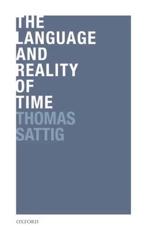 I am currently working on a review of Thomas Sattig's book: The Language and Reality of Time (Oxford UP, 2006) for Notre Dame Philosophical Reviews. This is a preview.
I am currently working on a review of Thomas Sattig's book: The Language and Reality of Time (Oxford UP, 2006) for Notre Dame Philosophical Reviews. This is a preview.
As the views are standardly characterized, endurantism is the view that objects persist by being fully present at different times, whereas perdurantism is the view that objects persist by having temporal parts at different times. On the most popular version of the latter view, temporal parts just are spatio-temporal regions. Endurantists insist that objects are never identical to spatio-temporal regions.
Sattig develops a new endurantist view according to which objects persist by being fully present at different spatio-temporal regions. Moreover, objects have properties at times insofar as the spatio-temporal regions they occopy at those times have these properties simpliciter. This view has some unexpected consequences, for example that spatio-temporal regions can be female, be happy, be married, be conscious, believe that it is raining, feel that the room is too hot, be mad at their spouse, and so forth.
Sattig does a very good job explaining why these unexpected consequences of his view are not counter to our intuitions (the explanation turns on the fact that spatio-temporal regions, on his view, do not have the properties at times)
However, Sattig notices a problem for his view: property abstraction. Consider the following sentences:
(1) John is happy
(2) John is such that he is happy
Or: John has the property of being a thing x such that x is happy
Property abstraction is widely regarded as a valid move. But, as Sattig observes, it appears to make trouble for his view. Consider:
(3) At t, John is identical to John.
By property abstraction, we get:
(4) At t, John is such that he is identical to John.
Or: at t, John has the property of being a thing x such that x is identical to John.
But if John has this property at t, then the spatio-temporal region he occupies at t has the property of being a thing x such that x is identical to John simpliciter. But surely only John can be identical to John.
Sattig notes that the problem of property abstraction is a problem, not just for his account, but also for perdurantism. He then offers the following solution.
Property abstraction -- e.g., the move from (1) to (2), or the move from (3) to (4) -- is indeed valid, but it is trivially valid. For (2) just has the same logical form as (1), and (4) just has the same logical form as (2). In other words, (2) and (4) are pleonastic paraphrases of (1) and (3).
I think, however, that this way of viewing property abstraction is problematic. Consider the following sentence:
(5) Every one of the students is happy
(5) contains a partitive noun phrase that embeds a definite description. By property abstraction we get:
(6) The students are such that every one of them is happy.
Or: The students X are such that every one of X is happy.
But it is widely agreed that sentences like (5) have the logical form given by (6). To arrive at the logical form of (6), we need property abstraction. Property abstraction reflects genuine syntactical movement. Since there is plenty of evidence for the syntactical movement in question, there is also plenty of evidence against the view that the logical form of (4) is very different from its surface form.
Tuesday, September 12, 2006
 Sattig on Endurantism and Property Abstraction
Sattig on Endurantism and Property Abstraction
Posted by
Brit Brogaard
at
10:42 AM
![]()
Labels: Language, Metaphysics
Subscribe to:
Post Comments (Atom)










3 comments:
Ow...
My head is now hurting.
My head is such that it is hurting.
Or: My head has the property of being a thing x such that x is hurting!
I'm afraid I'm a little confused about quite what the objection is. Is it to the claim that 3 and 4 share the same LF (likewise for 1 and 2)? Or are you questioning the inference from their sharing LF to property abstraction being a trivially valid step? Or neither?
Hi Aidan,
(3) and (4) need not have the same LF, even if they have the same truth-conditions. That was my point. In some cases, the LF will be the same. I offered an example of that. But in that case the statement that results from property abstraction indicates the LF (not vice versa).
So here is an improved argument.
at t, all the US presidents are identical to Bush.
By property abstraction/movement:
at t, the US presidents X are things X such that all the Xs are identical to Bush.
Note: following Boolos, plural quantified noun phrases may denote a single individual.
Given Sattig's position, it follows that the region(s) occupied by the US president at t are things X such that all the Xs are identical to Bush. But only Bush is identical to Bush.
Can we say that the statement that results from property abstraction is just a trivial pleonastic paraphrase of the original. Sure, if you wish. But the form of the statement that results from property abstraction is syntactically real. So the triviality move won't help in this case.
Post a Comment